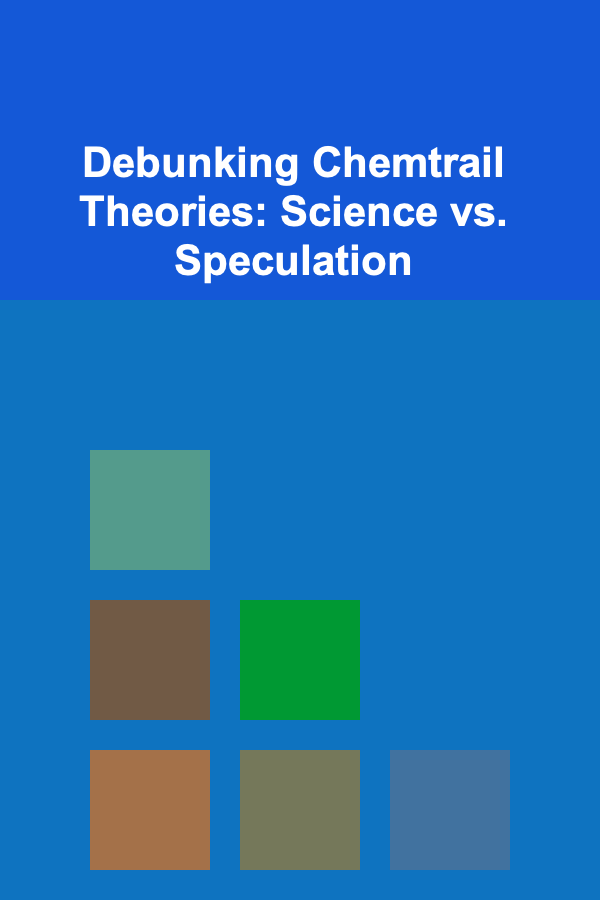
Debunking Chemtrail Theories: Science vs. Speculation
ebook include PDF & Audio bundle (Micro Guide)
$12.99$6.99
Limited Time Offer! Order within the next:

The "chemtrail" conspiracy theory posits that long-lasting condensation trails, or contrails, left by aircraft are in fact chemical or biological agents deliberately sprayed at high altitudes for undisclosed purposes. This theory, which gained prominence in the late 1990s, has persisted despite a lack of scientific evidence and numerous refutations from the scientific community. This article will delve into the key claims of the chemtrail theory, present the scientific explanations for contrails, analyze the evidence (or lack thereof) supporting the chemtrail theory, and provide effective strategies for engaging in constructive conversations with individuals who believe in it. It is crucial to address this topic with a combination of scientific rigor and empathy, understanding the underlying concerns that often fuel belief in conspiracy theories.
Understanding Contrails: The Scientific Basis
Before addressing the chemtrail theory directly, it's essential to understand the science behind contrails. Contrails are simply lines of condensed water vapor that are visible behind aircraft engines under specific atmospheric conditions. They are analogous to the breath you see on a cold day.
Formation of Contrails
The formation of contrails requires three primary conditions:
- Sufficient Humidity: The air must have enough moisture to allow for ice crystal formation.
- Low Temperature: The ambient temperature needs to be cold enough, typically below -40°C (-40°F), to facilitate the condensation of water vapor into ice crystals. This is usually found at high altitudes where commercial aircraft fly.
- Nucleation Particles: Tiny particles, often from aircraft exhaust, act as nuclei around which water vapor can condense and freeze. These particles can include soot, sulfur compounds, and metallic particles, all products of burning jet fuel.
The process is relatively straightforward: Jet engines combust fuel, producing water vapor as a byproduct. This hot, moist air mixes with the cold, ambient air at high altitude. The rapid cooling causes the water vapor to condense and freeze around the available condensation nuclei, forming ice crystals. These ice crystals, collectively, create the visible contrail.
Contrail Persistence and Spread
The duration and appearance of a contrail depend on atmospheric conditions, particularly humidity and wind shear.
- Short-lived Contrails: If the air is dry, the ice crystals will quickly sublimate (transition directly from solid ice to water vapor), causing the contrail to disappear relatively quickly.
- Persistent Contrails: If the air is humid, the ice crystals will persist and even grow as they absorb more moisture from the surrounding atmosphere. These persistent contrails can spread out due to wind shear, forming cirrus-like clouds. This spreading effect is a natural consequence of atmospheric processes and is well-documented.
- Wind Shear: Different wind speeds and directions at different altitudes can stretch and distort contrails, leading to complex and varied patterns in the sky.
The observed persistence and spreading of contrails are entirely consistent with atmospheric science. They are not evidence of intentional spraying.
Examining the Core Claims of the Chemtrail Theory
The chemtrail theory is not a monolithic entity; rather, it encompasses a range of interconnected beliefs and assumptions. Examining these claims is crucial for understanding and debunking the theory effectively.
Claim 1: Unusual Contrail Persistence and Behavior
The Claim: Chemtrails are distinguishable from regular contrails by their unusual persistence, spreading, and grid-like patterns in the sky.
The Rebuttal: As explained above, contrail persistence and spreading are directly linked to atmospheric humidity. High humidity allows ice crystals to persist and grow, leading to spreading. Grid-like patterns are often a result of increased air traffic density over specific air corridors. Changes in air traffic patterns and the increased prevalence of high-bypass turbofan engines (which produce more water vapor) can contribute to more frequent and noticeable contrails.
Claim 2: Chemical Analysis Reveals Toxic Substances
The Claim: Independent testing of soil, water, and air samples reveals the presence of unusual substances like barium, strontium, and aluminum in abnormally high concentrations, suggesting deliberate aerial spraying.
The Rebuttal: The presence of these elements is not necessarily indicative of chemtrails. These elements are naturally occurring in the environment and can be found in varying concentrations depending on the location. Furthermore, barium and strontium are used in various industrial processes, and aluminum is one of the most abundant elements in the Earth's crust. Attributing their presence solely to aerial spraying is a logical fallacy known as "correlation does not equal causation." Proper scientific testing requires rigorous controls, statistical analysis, and consideration of alternative sources. Often, chemtrail proponents' "evidence" is based on poorly controlled or misinterpreted data.
Moreover, the concentrations of these elements cited by chemtrail proponents are often within the normal range for soil and water. In cases where elevated levels are found, they can often be attributed to local sources such as industrial pollution, agricultural runoff, or natural geological variations. For example, some types of soil naturally contain higher levels of aluminum than others.
Claim 3: Government Conspiracy and Secrecy
The Claim: Governments and scientists are deliberately concealing the truth about chemtrails and their purpose.
The Rebuttal: The idea of a vast, coordinated global conspiracy involving thousands of scientists, government officials, and airline employees is highly improbable. Maintaining such a massive secret would be virtually impossible in the age of information. The logistics of regularly spraying chemicals from aircraft on a global scale would require immense resources and would be easily detectable by independent observers and monitoring systems.
Furthermore, the scientific community has repeatedly debunked the chemtrail theory through peer-reviewed studies and expert consensus reports. These efforts are readily available to the public. The perception of secrecy often arises from a misunderstanding of scientific processes and a distrust of established institutions.
Claim 4: Chemtrails are Responsible for Health Problems and Environmental Damage
The Claim: Chemtrails are causing a range of health problems, such as respiratory illnesses, skin rashes, and neurological disorders, as well as environmental damage like soil acidification and plant death.
The Rebuttal: There is no scientific evidence to support a direct causal link between contrails (or alleged chemtrails) and adverse health effects or environmental damage. The health problems cited by chemtrail proponents are often common ailments that can be attributed to various factors, such as air pollution, seasonal allergies, and stress. Environmental damage, such as soil acidification, is primarily caused by industrial pollution, acid rain, and agricultural practices.
If chemtrails were indeed responsible for widespread health problems, we would expect to see a statistically significant increase in the incidence of these conditions in areas with heavy air traffic. However, epidemiological studies have not found any such correlation.
The Power of Confirmation Bias and Cognitive Dissonance
Understanding the psychological factors that contribute to belief in the chemtrail theory is crucial for effective communication and potential persuasion.
Confirmation Bias
Confirmation bias is the tendency to selectively seek out and interpret information that confirms pre-existing beliefs while ignoring or downplaying contradictory evidence. Individuals who believe in the chemtrail theory are more likely to notice and share images of persistent contrails, interpret ambiguous data as evidence of chemical spraying, and dismiss scientific explanations as part of the conspiracy.
Cognitive Dissonance
Cognitive dissonance is the mental discomfort experienced when holding conflicting beliefs or values. When presented with evidence that contradicts their belief in chemtrails, individuals may experience cognitive dissonance and attempt to reduce this discomfort by rationalizing their belief, discrediting the source of the information, or strengthening their commitment to the chemtrail theory.
The Appeal of Conspiracy Theories
Conspiracy theories can provide a sense of order and control in a complex and unpredictable world. They can also offer a sense of belonging and community for individuals who feel marginalized or disenfranchised. By believing in a conspiracy theory, individuals may feel like they possess secret knowledge that others lack, giving them a sense of superiority and importance.
Evidence Against the Chemtrail Theory: A Scientific Consensus
The scientific community overwhelmingly rejects the chemtrail theory. Numerous studies and expert reviews have found no evidence to support the claims made by chemtrail proponents.
The 2016 Carnegie Institution for Science Study
In 2016, researchers at the Carnegie Institution for Science conducted a survey of atmospheric scientists and geochemists, asking them whether they had encountered evidence supporting the chemtrail theory in their work. The study, published in the journal Environmental Research Letters, found that 76 out of 77 scientists (98.7%) reported that they had not encountered any evidence of a secret large-scale atmospheric program (SLAP), the term used by the researchers to describe the alleged chemtrail spraying.
The researchers concluded that the evidence cited by chemtrail proponents could be explained by other factors, such as normal contrail formation and natural variations in atmospheric composition.
Expert Consensus Reports
Several scientific organizations, including the U.S. Environmental Protection Agency (EPA), the National Oceanic and Atmospheric Administration (NOAA), and NASA, have issued statements debunking the chemtrail theory. These organizations emphasize that contrails are a natural phenomenon caused by jet engine exhaust and atmospheric conditions and that there is no evidence of deliberate chemical spraying.
Strategies for Engaging in Constructive Conversations
Debunking the chemtrail theory effectively requires more than just presenting scientific facts. It requires empathy, patience, and a willingness to engage in respectful dialogue.
Listen and Acknowledge Concerns
Begin by listening to the individual's concerns and acknowledging their fears about potential environmental or health risks. Avoid being dismissive or condescending. Understanding the underlying motivations behind their beliefs is crucial for building trust and fostering open communication.
Ask Open-Ended Questions
Instead of directly challenging their beliefs, ask open-ended questions that encourage them to think critically about the evidence they have encountered. For example, you could ask: "What sources of information do you trust the most when it comes to this topic?" or "What would it take to convince you that chemtrails are not real?"
Present Scientific Evidence Clearly and Simply
Present scientific explanations for contrail formation and atmospheric processes in a clear and accessible manner. Avoid using technical jargon and provide visual aids, such as diagrams or videos, to illustrate your points. Refer to reputable sources of information, such as peer-reviewed scientific studies and reports from government agencies.
Focus on Common Ground
Try to find common ground by acknowledging that environmental pollution and health concerns are legitimate issues. Explain that addressing these issues requires evidence-based solutions and that focusing on unsubstantiated conspiracy theories can distract from real problems.
Avoid Aggressive or Argumentative Language
Avoid using language that is aggressive, argumentative, or disrespectful. Remember that people are more likely to listen to your perspective if they feel that you are genuinely trying to understand their point of view. Maintain a calm and respectful tone, even if you disagree strongly with their beliefs.
Be Patient and Persistent
Changing someone's deeply held beliefs is often a slow and gradual process. Don't expect to convince them in a single conversation. Be patient and persistent in your efforts to present scientific evidence and engage in respectful dialogue. It is important to recognize that some individuals may be unwilling to change their minds, regardless of the evidence presented.
Highlight the Importance of Critical Thinking
Encourage critical thinking skills by discussing the importance of evaluating sources of information, identifying logical fallacies, and separating evidence from speculation. Help them understand the difference between anecdotal evidence and scientific evidence.
Beyond Debunking: Addressing Underlying Concerns
The persistence of the chemtrail theory is often rooted in deeper anxieties about government transparency, environmental degradation, and the potential for technological abuse. Simply debunking the theory without addressing these underlying concerns is unlikely to be effective.
Promoting Science Literacy
Improving science literacy among the general public is crucial for combating misinformation and promoting critical thinking. Science education should emphasize the scientific method, the importance of peer review, and the limitations of scientific knowledge.
Increasing Transparency and Accountability
Governments and scientific institutions should strive to be more transparent and accountable in their actions. This can help to build trust and reduce the perception of secrecy that fuels conspiracy theories. Providing clear and accessible information about scientific research and government policies can help to dispel misinformation and promote informed decision-making.
Addressing Environmental Concerns
Addressing legitimate environmental concerns, such as air pollution and climate change, is essential for alleviating anxieties that contribute to belief in conspiracy theories. Taking concrete steps to protect the environment and promote sustainable practices can help to restore trust in institutions and reduce the perception that governments are indifferent to environmental risks.
Conclusion: Science and Reason as Tools for Understanding
The chemtrail theory is a prime example of how misinformation and speculation can flourish in the absence of scientific understanding. While the theory lacks any credible scientific evidence, it is important to approach it with empathy and a willingness to engage in respectful dialogue. By understanding the scientific basis for contrail formation, examining the core claims of the chemtrail theory, and addressing the underlying concerns that fuel belief in it, we can promote science literacy, critical thinking, and informed decision-making. Ultimately, science and reason are our most powerful tools for understanding the world around us and addressing the challenges we face.

Creative Brand Identity: A Comprehensive Guide to Graphic Design for Business Professionals
Read More
How to Categorize Your Antiques by Era or Style
Read More
How To Choose Wine Based on Your Mood
Read More
How To Deal with Defiant Behavior
Read More
How to Find Reliable Remodelers in Your Area
Read More
How to Keep Your Home's Shed and Storage Areas Organized and Safe
Read MoreOther Products

Creative Brand Identity: A Comprehensive Guide to Graphic Design for Business Professionals
Read More
How to Categorize Your Antiques by Era or Style
Read More
How To Choose Wine Based on Your Mood
Read More
How To Deal with Defiant Behavior
Read More
How to Find Reliable Remodelers in Your Area
Read More